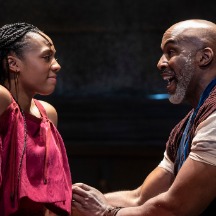Aside from my everlasting favorite, “The Wiz,” A.D. 16 was the most creative production I have ever seen. And, by the audience’s consistent laughter and applause, I was not the only person loving this short, two-hour, colorful play at Olney Theater, about 45 minutes north of Washington, D.C.
The selection of an extremely diverse cast, including racial and body type, set the stage for an open imagination that playwright Cinco Paul hatches. “Only the Jesus character,” seemed typical says viewer Donovan Anderson. I will add that The Sanhedrin Officers, whose characters played a similar enforcer role as did the flying monkeys in “The Wiz,” were stereotypically dressed in black.
"Though this show is set in A.D. 16, musically it’s set in the era of 80s and 90s radio music."
Biblically, according to some scholars, the majority of the women in the Bible are unnamed, with named women making up only 5.5 to 8 percent of all named characters in the Christian Good Book. But, not in this play. The star is Mary Magdelene and actress Phoenix Best owns the part.
The fast-paced production starts when Mary and her father Jacob (Alan H. Green) moves to Nazareth and next door to the carpenter and his family whose son is named Jesus, performed naturally by Ben Frankauser. Jesus is the oddball in the community. He hangs out with the lepers and tells short stories such as why one should look for one sheep lost from a flock.
A.D. 16 – A Play You Hope to Be Blessed to See
Entertainment


According to some scholars, a woman in this part of the world and time would have her father’s name until she was married, typically around 13-years-old. Mary Magdalene’s name denotes that she was unattached to any man and writer Paul went from there to pen a masterful musical mixed with familiar stories and creative updated actions and response. (Publisher’s Point: We limit saying what the conditions where for women to this time and place knowing that Hatshepsut, female king of Egypt, reigned in her own right c. 1473–58 B.C.E.)
“Though this show is set in A.D. 16, musically it’s set in the era of 80s and 90s radio music,” explains Orchestrations/Music Supervisor Doug Besterman. With the orchestra hidden under the stage and with the music so interwoven with the flow of the production, I did not grasp that the musicians were in the theater until their post-show introduction.
Aside from the acting, the words, and the music being tightly interwoven, so were the costumes, scenery, and many other aspects of the production. When Mary sings, “It’s not easy being a girl,” she observes all the teenaged pregnant women whose only sense of being is being attached to a man. “Leave her alone,” demands Jesus as he comes to her rescue and she is overcome with teenage emotions.
Instead of talking in pseudo saintly Old English, the two eventually break into a loving music video-like scene with great orchestrion and Jesus crooning Mary with more sex appeal than Robin Thicke. Wow!
“Though this show is set in A.D. 16, musically it’s set in the era of 80s and 90s radio music,” explains Orchestrations/Music Supervisor Doug Besterman. With the orchestra hidden under the stage and with the music so interwoven with the flow of the production, I did not grasp that the musicians were in the theater until their post-show introduction.
Aside from the acting, the words, and the music being tightly interwoven, so were the costumes, scenery, and many other aspects of the production. When Mary sings, “It’s not easy being a girl,” she observes all the teenaged pregnant women whose only sense of being is being attached to a man. “Leave her alone,” demands Jesus as he comes to her rescue and she is overcome with teenage emotions.
Instead of talking in pseudo saintly Old English, the two eventually break into a loving music video-like scene with great orchestrion and Jesus crooning Mary with more sex appeal than Robin Thicke. Wow!
Advertisers | Contact Us | Events | Links | Media Kit | Our Company | Payments Pier
Press Room | Print Cover Stories Archives | Electronic Issues and Talk Radio Archives | Writer's Guidelines






